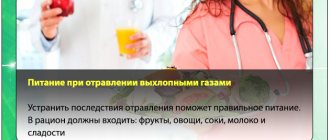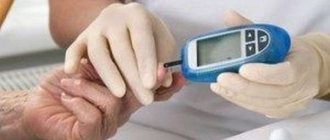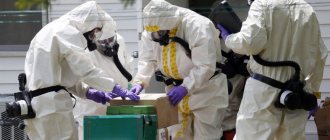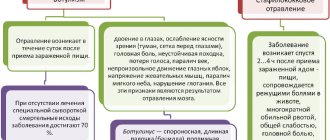Topic: FOOD POISONING.
CONTROL QUESTIONS
1. Definition of food poisoning. Common signs of food poisoning.
2. Classification of food poisoning.
3. Toxic infections. Etiology, clinic. Conditions necessary for the occurrence of toxic infections.
4. Prevention of toxic infections.
5. Staphylococcal toxicosis, clinical picture, etiology and prevention.
6. Botulism, clinical picture, epidemiology, prevention.
7. Mycotoxicosis. Etiology, clinical picture and prevention.
8. Mushroom poisoning. Clinic and prevention.
9. Poisoning by products of animal and plant origin. Their features and prevention.
10. Investigation of food poisoning.
Food poisoning
– these are acute (less often chronic) non-contagious (non-contagious) diseases that arise as a result of eating food contaminated with microorganisms or containing toxic substances of a microbial or non-microbial nature.
Food poisoning is a group of diseases that differ in etiology (causal factor) and clinical picture.
They are united into a single group by a number of common characteristics. Common signs of food poisoning include:
- acute, sudden onset of the disease;
- simultaneous onset of the disease in a group of people;
- connection of diseases with the consumption of any food product;
- territorial limitation of diseases to the place of consumption or place of purchase of the food product;
- stopping the emergence of new cases of disease after destruction or removal of the culprit product;
- absence of transmission of the causative factor of food poisoning from a sick person to a healthy one. This symptom distinguishes food poisoning from infectious diseases.
Question: What is the difference between food infections and food poisoning?
The site provides reference information for informational purposes only.
Diagnosis and treatment of diseases must be carried out under the supervision of a specialist. All drugs have contraindications. Consultation with a specialist is required! What is the difference between foodborne infections and food poisoning?
The clinical signs of food poisoning and foodborne illness are very similar; When establishing a diagnosis, questioning the patient and laboratory tests are of great importance. Without this, it is difficult even for an experienced doctor to establish the correct diagnosis.
What are the differences between food poisoning and food (intestinal) infections?
- Food poisoning is not a contagious disease, but intestinal infections are transmitted from a sick person to a healthy one.
- Food poisoning occurs only when eating poor quality foods. Intestinal infections can be transmitted both through food and through water, soil, and household items.
- The incubation (latent) period for food poisoning is short: from half an hour to 24 hours. For intestinal infections, this period is longer: from 2-3 days to several weeks.
- Food poisoning is characterized by widespread and simultaneous illness of people who ate the same food; This is not observed in foodborne infections.
- The duration of the disease for food poisoning is on average 1-3 days, and for intestinal infections - from one to several weeks.
Nausea, abdominal pain, vomiting and diarrhea can be signs of both poisoning and intestinal infection .
These diseases differ from each other in etiology, some symptoms and treatment methods. This article discusses food infections and poisoning, the differences in their manifestations and treatment, and methods for making an accurate diagnosis.
Concept of food intoxication?
They call it a short-term acute disease that develops against the background of damage by opportunistic microorganic pathogens or toxic products of their vital activity.
Typically, their penetration occurs when eating food that has expired or has spoiled due to improper storage.
Normally, a small number of such organisms do not harm humans, but if their population increases, they provoke the development of food poisoning.
Food poisoning also occurs due to the consumption of inedible mushrooms or berries, violations of sanitary and hygienic rules such as dirty hands, unwashed or insufficiently washed foods, eating from unwashed dishes, etc.
It is quite easy to confuse a food infection with intoxication, since these diseases have a lot in common. How are these pathological conditions similar?
- Possible transmission through food.
For the disease to develop, it is enough to eat contaminated, low-quality or spoiled food. - The lesion is localized in the gastrointestinal tract
, and the pathological process may involve large or small intestinal structures or the stomach. Bacterial or toxic pathogens, after penetration into the stomach, provoke local inflammatory lesions, causing gastroenteritis. - Clinical manifestations.
For both pathological varieties, symptoms such as nausea and vomiting, diarrhea, increased gas formation and severe dehydration are typical. The last symptom is caused by severe vomiting and diarrhea, resulting in enormous fluid loss. - The development of pathology always follows one cyclical scenario
- first there is a certain period of incubation, then the height of the pathology begins, and then it is replaced by a recovery stage.
So, there is quite a lot in common between intestinal infections and poisoning, but they also have significant differences.
Description and etiology
Food poisoning and intestinal infections primarily differ in etiology , that is, the cause of the development of the disease. Poisoning develops as a result of intoxication of the body with toxins that are formed in spoiled and rotten foods. Intestinal infections are caused by highly pathogenic microorganisms that can cause inflammation in the walls of the digestive tract and lead to intoxication syndrome.
Intestinal infections
In a disease of infectious origin, the clinical picture is caused by the entry of pathogenic microorganisms into the digestive tract . These can be viruses and bacteria.
Please note that intestinal infections are contagious; a person can become ill with them after household contact with a carrier of the pathogen.
The most common types of intestinal infections include:
- salmonellosis is a bacterial disease caused by bacteria. Infections can enter the human body through meat products and eggs; a person can also become infected during household contact with a sick person;
- dysentery is a bacterial intestinal infection that is transmitted through contaminated water, dairy products, from a sick person to a healthy person;
- rotavirus infection, or “intestinal flu,” is a contagious viral disease transmitted by the fecal-oral route. It is a seasonal pathology. The peak of the disease comes in winter.
Please note that rotavirus infection is often confused with influenza and ARVI. With this disease, viral intoxication develops, the same as with a cold. The main difference between rotavirus infection is the appearance of diarrhea and vomiting.
With an intestinal infection, pathogenic microorganisms entering the intestines cause severe inflammation . These diseases are accompanied by a strong intoxication syndrome and are dangerous for people. They are especially difficult for young children, who are very sensitive to intoxication and dehydration.
Food poisoning
Food poisoning develops for a number of reasons, listed below:
- Eating low-quality and spoiled foods . This could be food that has expired or was stored at the wrong temperature. In such products, opportunistic bacteria multiply, which in themselves are not dangerous to humans, and symptoms of poisoning develop from the toxins produced by them and from the products of their vital activity.
- Insufficient heat treatment of meat and fish.
- Failure to comply with sanitary and hygienic norms and rules. Dirty hands, unwashed dishes, poorly washed fruits and vegetables can lead to poisoning .
- Eating poisonous plants or mushrooms.
Please note that food poisoning is not contagious. You can calmly communicate with a poisoned person without fear of becoming infected, but food that the sick person ate cannot be eaten.
Possible complications
Complications of intestinal infections and poisoning:
- dehydration of the body (with vomiting and diarrhea, accelerated removal of fluid from the body is observed);
- liver damage (the organ neutralizes poisons and toxins that enter the body with food and are secreted by pathogenic microorganisms);
- infectious-toxic shock accompanied by circulatory disorders;
- acute renal failure;
- pneumonia caused by vomit entering the respiratory tract;
- intestinal dysbiosis.
Viral infections are especially dangerous during pregnancy. Rotavirus often affects fetal development, causing abnormalities.
Distinctive features
Distinctive features of poisoning and intestinal infections help the doctor to suspect a particular pathology. Some symptoms are very specific, indicating a specific pathology.
Speaking about the distinctive features, we must not forget that the course of the same disease in different people can differ and be individual. There are also atypical forms of intestinal infections and poisonings that occur with mild symptoms.
Please note that you can try to distinguish poisoning from an intestinal infection by the symptoms of the disease. The final diagnosis is made only on the basis of laboratory tests of the body.
The following are the distinctive features:
- The incubation period for food poisoning is shorter than for intestinal infection. When consuming low-quality, spoiled food, symptoms of poisoning develop during the first 6 hours. With an intestinal infection, the incubation period can last several weeks .
- Localization of the greatest damage to the digestive tract. Thus, in case of poisoning, inflammation develops in the mucous membrane of the stomach and duodenum. In case of intestinal infection, the large or small intestine is affected.
- Intoxication syndrome is more pronounced with intestinal infection. The temperature can rise to 39 degrees. With food poisoning, body temperature does not rise above 37.5 degrees .
- Some intestinal infections differ in the appearance and consistency of stool. For example, with salmonellosis, the stool is loose, green and foamy. With dysentery, the stools are watery, streaks of blood can be seen in them; with cholera, the stool looks like rice water.
Poisoning by products of plant origin
- Solanine. A characteristic substance for the nightshade family. Protects plants from fungal diseases and insects. The largest amount is found in unripe fruits. Modern potato varieties have been selected for low solanine content. Do not eat potatoes that have been exposed to direct sunlight. The skin of such tubers becomes green.
- Amygdalin, or vitamin B17, is dangerous in large doses. Contained in the kernels of bitter almonds, peach, cherry, and apricot.
- Cottonseed oil (gossypol). Currently, it is difficult for them to get poisoned. During production, cottonseed oil is purified to a certain safe percentage of the substance content. Gossypol strengthens the immune system by stimulating the production of interferon, kills bacteria, viruses, and cancer cells. But at the same time, it has a specific effect on the human reproductive system and leads to infertility.
Based on its positive aspects, scientists have created medicines. And cottonseed oil, purified from gossypol, is used for deep frying.
- Fasin. Contained in raw beans. If you follow the processing rules (soaking and boiling), beans are completely safe.
Principles of diagnosis and diagnosis
The attending physician first takes a history and examines the patient. He should indicate the time when the first symptoms appeared and list the foods you ate over the past 24 hours. You should also tell us what treatment measures you took on your own before seeking medical help, what concomitant diseases you suffer from, what pills you constantly take, what you are allergic to.
As we mentioned above,
the final diagnosis can only be made on the basis of laboratory research methods .
In case of poisoning or intestinal infection, diagnostics is aimed not only at making an accurate diagnosis, but also at assessing the state of the entire body and searching for possible complications. The following are laboratory and instrumental examinations that may be prescribed in the event of food poisoning or intestinal infection:
- A general blood test with a detailed leukocyte formula is a very informative study. With it you can:
- see the presence of a bacterial or intestinal infection;
- determine the severity of the inflammatory process in the body;
- roughly estimate the degree of dehydration (based on hematocrit);
- suspect helminthic infestation;
- identify anemia or hemolysis (can develop from poisoning with poisonous mushrooms).
- A general urine test is performed to identify abnormalities in kidney function. It is worth noting that acute inflammation of the kidney structures (pyelonephritis) can imitate poisoning. With its atypical course, diarrhea and abdominal pain may develop. At the same time, the level of leukocytes in the urine increases.
- Bacteriological examination of stool can detect intestinal infection.
- A biochemical blood test is necessary to diagnose abnormalities in the electrolyte balance, as well as to identify disorders of the liver, kidneys, and pancreas.
- Ultrasound examination of internal organs is performed to assess the condition of the gallbladder, liver, pancreas and kidneys . It is these organs that are primarily affected by poisoning or intestinal infection. Identifying abnormalities in them helps the doctor prescribe the necessary treatment and prevent the progression of their damage.
- Electrocardiography is performed in cases of severe dehydration and electrolyte imbalance. An ECG is necessary to detect rhythm abnormalities.
Plant products that are poisonous in nature
Some plants and mushrooms can cause severe poisoning or death. Often, even an experienced mushroom picker finds it difficult to determine the type of mushroom. The number of poisonous herbs is much smaller, and they are easier to identify.
“Mushrooms eaten by worms are not poisonous,” is the leading opinion that ruins many inexperienced mushroom pickers. It is a mistake to consider mushrooms that exude a “delicious” mushroom aroma and “harmless-looking” to be non-poisonous. The pale toadstool, according to the few testimonies of survivors, has a very pleasant mushroom aroma and a subtle nutty taste, which does not prevent it from causing death within a period of 3 to 10 days from the moment of consumption.
The most beautiful cobweb
The striking red fly agaric, universally known as poisonous, leads to death after eating 4 kilograms of the pulp. And after boiling twice in compliance with the technology, it is completely edible. Much more dangerous are the fringed galerina and the beautiful cobweb, which are confused with honey mushrooms, the smelly fly agaric, similar to champignons, and the fibers, similar to russula.
The thin pig, which has long been considered edible, stands apart. Pig toxins (lectins) do not always cause death immediately. The point is the specific action of lectins: they are fixed on the membrane of red blood cells and provoke the development of autoimmune reactions. The immune system begins to consider its own red blood cells “with a trailer” of lectins as foreign elements and destroys them. Anemia develops. Fragments of destroyed red blood cells damage the renal glomeruli, and death occurs due to renal failure.
Conditionally edible mushrooms usually contain substances that can cause mild stomach poisoning. A large number of these types of mushrooms have high taste and contain nutrients valuable for the human body. Poisoning occurs due to non-compliance with processing rules. Boiling or soaking (from 3 to 40 days), depending on the type, is enough to get a tasty dish.
Each geographical zone has its own list of poisonous plants and mushrooms. To avoid poisoning, purchase special reference books. If you love collecting mushrooms and want to expand the types of mushrooms you collect, explore all the "mushroom look-alikes." These are poisonous types of mushrooms, similar to edible ones.
The most memorable distinctive features of poisonous mushrooms may disappear under the influence of natural factors. Without a “skirt” on the leg, the pale grebe looks like an overgrown russula. The white dots on the cap and “skirt” of the panther, characteristic of fly agarics, are washed away by rain. Even an experienced mushroom picker can get poisoned.
Among the plants, Sosnovsky's hogweed stands out. Initially, it was cultivated for the purpose of landscaping areas along highways. The toxicity of hogweed was quickly revealed, but its amazing survival rate did not allow the plant to die. Successfully self-dispersing, it continues to spread to this day. Powerful leaves and stems, a large beautiful white umbrella, a strong unpleasant smell of kerosene.
Hogweed Sosnovsky
Often it is the white umbrellas of Sosnowski's hogweed that attract children and adults. If you tear off an umbrella, you can get a severe burn. The sap of the plant is phototoxic - the damaging effect increases many times under sunlight. There are known cases of loss of vision when juice gets into the eyes.
Wash the area where hogweed juice comes into contact with the skin as soon as possible and wrap it with a cloth to avoid exposure to sunlight. Do not touch other areas of the skin; consult a doctor as soon as possible.
Differences in treatment
The main difference in the treatment of intestinal infection and food poisoning is the need for antibiotic therapy. With laboratory confirmation of the bacterial etiology of the disease, the doctor prescribes antibacterial drugs, which the patient should take strictly according to the schedule.
Please note that viral intestinal infections are treated in the same way as food poisoning. Antibiotics or antiviral drugs are not prescribed.
The remaining components of the treatment are almost the same. Diet, drinking plenty of fluids, antispasmodics, enzymes, antiemetics - all this helps the patient recover faster .
It is worth noting that in case of poisoning by poisonous mushrooms, the patient may need hemodialysis - purification of the blood from poisons using an artificial kidney apparatus.
Poisoning and intestinal infections have many similarities and differences. Only an experienced doctor can make an accurate diagnosis after examining, collecting an anamnesis and examining the patient. Treatment is prescribed by a doctor after identifying the cause of the disease. Antibiotics help with intestinal infections. You cannot prescribe them for yourself; you can take them only on the recommendation of a doctor.
An intestinal infection is very often confused with food poisoning. Because they have similar symptoms: nausea, abdominal pain, vomiting, diarrhea. However, there are also differences between them. How to distinguish poisoning from an intestinal infection?
Difference from rotavirus
Rotavirus refers to microorganisms that, upon penetration into the body, provoke the development of infectious lesions of the gastrointestinal tract.
The maximum activity of rotavirus is observed in the autumn-winter season.
Infection occurs through contact with a rotavirus carrier or an infected person. The pathogen enters the body through the mouth with drinks or food. From the first day of infection, rotavirus begins to be excreted along with feces.
But in case of poisoning, damage to the gastrointestinal tract occurs under the influence of the consumption of low-quality products that do not require heat treatment before consumption, for example, sausage, semi-finished products, a variety of cheeses or smoked meats.
With rotavirus, the symptoms are reduced to the following manifestations:
- Feeling of general weakness in the body;
- Epigastric pain and vomiting symptoms;
- Hyperthermia that occurs for several days;
- Lack of desire to eat, even with severe long-term fasting;
- Painful sensations when swallowing;
- There is a pronounced white coating on the surface of the tongue;
- There is a constant rumbling in the patient's stomach;
- Redness of the conjunctiva and mucous membrane of the throat;
- The patient is bothered by a slight cough, and the nose may be stuffy.
With food intoxication, most of these symptoms are absent. Patients usually complain of abdominal pain, nausea and vomiting symptoms, diarrhea, and sometimes fever. Myalgia and headaches may appear, chills may bother you, and with severe vomiting and diarrhea, dehydration quickly develops.
In addition, intoxication develops rapidly and is associated with food consumption, while rotavirus cannot be associated with food.
Also, rotavirus infection, unlike poisoning, is characterized by seasonality, frequent infection of pediatric patients, and symptoms of ARVI. Also, if one family member is infected with rotavirus disease, the rest of the household will also become ill. In case of poisoning, there is no such epidemic.
In general, intoxications and infectious lesions of the gastrointestinal tract have a lot in common, but they also have significant differences. It is quite difficult for a person ignorant of medicine to make a diagnosis on their own, so the diagnosis should be carried out exclusively by a specialist.
Therapeutic measures also differ significantly. In different cases, the spectrum accepted is individual. Therefore, self-treatment can worsen the situation. It is better to entrust the treatment to a specialist.
Video about the signs of food poisoning and acute intestinal infections:
The article discusses a rather interesting topic that will allow you to get answers to the following questions: how do doctors distinguish an intestinal infection from poisoning and how can you do it yourself?
In order for an ordinary person to understand the difference between food poisoning and an intestinal infection, one needs to become familiar with the symptoms, as well as the characteristics of the development and course of these diseases.
Intestinal infections
A disease of infectious origin is the result of the penetration of viruses and bacteria into the human body.
Basically, intestinal infections are of the following types:
- Salmonellosis. With this disease, dangerous microorganisms can enter the digestive system with meat or eggs. You can also get sick from contact with an infected person.
- Dysentery. This bacterium spreads through infected water, milk, or upon contact with a sick person.
- Rotavirus infection. It is a seasonal contagious disease that is spread by the fecal-oral route. The peak of infection is winter.
What are infectious lesions of the gastrointestinal tract?
Infectious lesions of the intestines are caused by the penetration of various kinds of microorganisms and pathogens into the body. These main pathologies include paratyphoid or typhoid fever, rotavirus infections and dysentery, as well as salmonellosis, escherichiosis, etc.
A characteristic feature that closely unites these pathologies is acute inflammation of any part of the gastrointestinal tract due to infection with an infectious pathogen.
The source of the disease is actually microorganisms such as viruses or bacteria. For each of the pathogens, there is a preferred section of the gastrointestinal tract for habitation, to which it reaches, and only then, after a certain time (hours or days after infection), the disease begins to develop.
Food poisoning
The causes of food poisoning are:
- Consumption of spoiled products: expiration date, improper storage. They form pathogenic bacteria that produce dangerous toxins, thereby causing symptoms of poisoning.
- Neglect of sanitary and hygienic rules. Unwashed hands or dishes, or insufficiently washed fruits and vegetables can cause poisoning.
- Insufficient heat treatment of meat or fish.
- Consumption of poisonous mushrooms, berries, herbs.
Causes
Food toxic poisoning occurs as a result of consuming food or water that contains chemical, plant or animal poisons:
- inedible mushrooms, or mushrooms collected along highways, near chemical plants and which have accumulated harmful compounds,
- poisonous plants (nightshade, wolfberry, henbane),
- chemicals (toxins, heavy metal salts, preservatives, dyes).
Foodborne illnesses occur as a result of eating spoiled food or food contaminated with harmful microbes.
These include:
- salmonellosis, listeriosis, botulism, proteus, clostridiosis,
- opportunistic flora (staphylococcus, Escherichia coli),
- viruses (rotavirus, enterovirus).
Similarities between diseases
Often, it is difficult to recognize the disease based on symptoms alone without examining a specialist and taking certain tests. It is very difficult to understand poisoning or an intestinal infection that worries a patient, because they have many similarities. Both ailments are quite unpleasant.
- The digestive system is initially affected. Pain in the stomach and intestines may occur.
- These diseases are cyclical. Both diseases have an incubation period, followed by the height of the disease and subsidence.
- Disease-causing bacteria are spread through contaminated food.
- The signs of the disease are very similar: nausea, vomiting, abdominal pain, diarrhea.
- Due to the sudden loss of fluid from the body and exposure to toxins, the cardiovascular and nervous system reacts after some time: dizziness, weakness, and abnormal pulse and blood pressure.
So how can you distinguish poisoning from an intestinal infection? Which disease is more difficult? It depends on the specific case. While there are many similarities, there are also significant differences.
How are the diseases similar to each other?
Food poisoning and food infections have much in common and are similar in their clinical picture and the course of the disease. It is because of the similarity of symptoms that they are constantly confused with each other.
The common features are listed below:
- Damage to the digestive tract. Toxins or bacteria, once in the gastric cavity, cause local inflammation of the mucous membrane and lead to gastroenteritis.
- Transmitted through food. In order to get sick, you need to eat something of poor quality or contaminated.
- Symptoms: abdominal pain, nausea, vomiting, diarrhea, increased gas formation and intestinal colic.
- Dehydration is a condition in which a large amount of fluid is removed from the body. Poisoning or intestinal infection is accompanied by severe dehydration of the body (loss of water) due to vomiting and diarrhea.
- The course of diseases always follows a standard pattern: first, a certain incubation period during which there are no clinical manifestations of poisoning or intestinal infection. Then comes the height of the disease, which is replaced by a period of recovery.
Differences
It is not always possible to conduct special studies to find out the type of disease. Therefore, you should know the difference between an intestinal infection and food poisoning.
- Rotavirus infection has a long incubation period: up to 14 days. At this time, the infected person feels a general malaise, but no pronounced manifestations of the disease have yet been observed. With food poisoning, symptoms appear several hours after eating spoiled food because toxins have already been released, which accelerates the progression of the disease. With an intestinal infection, the release of toxins occurs after microorganisms enter the stomach.
- In the case of food poisoning, the stomach and the initial parts of the small intestine are mainly affected. An intestinal infection affects the small and large intestines.
- With rotavirus infection, a child over 2 years of age experiences abdominal pain, vomiting, and diarrhea.
- With food poisoning, a person's temperature can rise to 39 degrees at the onset of the disease. In the case of rotavirus infection, after a couple of days it can reach 40 degrees.
- Simple food poisoning without complications lasts from 1 to 3 days. Rotavirus infection can last more than 10 days.
Symptoms and signs
In case of poisoning and intestinal infections, the following symptoms are observed:
Treatment
If signs of intestinal infection are evident, it is necessary to provide first aid to the patient. It means the following:
- Hygiene rules must be observed: the infected person must use separate utensils and towels.
- If you have vomit, you should first rinse your stomach with warm boiled water, you can add a little potassium permanganate. Next, you need to induce vomiting and repeat this process several times until the water is clear.
- It is extremely important not to lead the patient to dehydration. In childhood it develops very quickly. In case of profuse and frequent vomiting, the infected person should be given 20 ml of water every 5-10 minutes. To restore the body, the necessary rehydration agents are prescribed. You should also make sure that the poisoned person drinks 2 liters of water and green tea per day.
- If the vomiting does not stop, you can take an antiemetic.
- For diarrhea, the doctor may prescribe enterosorbents that help remove toxins from the intestines and normalize stool.
- If the temperature is high and the situation of the infected person worsens, the doctor prescribes the necessary antibacterial agents.
Oatmeal and rice porridge, low-fat fermented milk products, slightly dried white bread, crackers, low-fat broths, steamed cutlets, vegetable purees, boiled or baked vegetables are recommended.
How to identify dangerous products
Foods that have been stored for some time after preparation are potentially dangerous, although freshly prepared foods can also cause poisoning.
There are several signs:
- the product has expired or is about to expire,
- its packaging is damaged or has defects (dents, abrasions, unclear paint),
- the product has an uncharacteristic odor,
- the taste and color of the product is changed,
- consistency is heterogeneous, layered,
- When stirring or heating, gas bubbles appear,
- there is sediment at the bottom, if the product is liquid, transparency is impaired.
Characteristics of food poisoning
A feature of foodborne infections and toxic poisoning is a short incubation period, about 2-6 hours, and rapidly developing manifestations.
In addition, these diseases are usually dangerous for others and occur in the form of outbreaks in a family or group, in all or almost all who have consumed these products.
Even if the product is normal in appearance and taste, poisoning can occur, since it could have been contaminated with dangerous microbes as a result of cooking from a sick person, but the microbes have not yet had time to multiply and spoil the dish.
Traditional methods
With a mild form of this disease, it is not necessary to purchase medications. You can use traditional methods of treatment, which also work well:
- To prevent dehydration, you need to drink a saline solution. To prepare it, you need to dilute 1 tsp in a liter of boiled water. salt, 2 tbsp. l. sugar and 1 tsp. soda Then you should induce vomiting and drink another glass. Do this several times. You need to drink 2 liters of this solution per day.
- If your temperature rises slightly, you should drink warm chamomile tea several times a day. To prepare the drink, brew a teaspoon of dry chamomile with one glass of boiling water, strain after 15 minutes. To prevent vomiting again, you should take 1 tbsp of this drink. l. every five minutes until the glass is empty.
- To restore stool during diarrhea, you can drink a starch solution. It is necessary to dilute 1 tbsp in a glass of warm water. l. starch.
- For symptoms of conjunctivitis that occur with a viral infection, you should wash your eyes with brewed black tea several times a day.
- You can restore your stomach with dill water. To prepare it, you need to steam the ground dill seeds at the rate of 1 tsp. products for 200 ml of water. Then strain the medicine and drink 3 times a day before meals.
To restore the intestinal microflora, you should consume low-fat fermented milk products, but you need to introduce them into the diet with caution: 1 tbsp. l. in a day.
Video: food poisoning or infection?
Drug therapy for E. coli poisoning
Course of treatment for poisoning:
- Cleansing the body of toxins. It is necessary to rinse the stomach in the first hours after eating expired or bacteria-contaminated products. Medicines (sorbents), toxins, poisons and alkaloids are eliminated fairly quickly.
- Restoration of water-salt balance. Solutions are introduced to replenish fluid deficiency in the body.
- Symptomatic therapy. Painkillers, antispasmodics and antipyretics are used.
- Rehabilitation treatment. Take medications that normalize intestinal microflora.
The drug therapy regimen includes the following drugs:
- Activated carbon. The initial dose for adults is 10-20 tablets, for children - 5-10 tablets. 3 hours after the first administration, the dose is changed - 2-4 tablets. Take the drug at intervals of 4 hours. Helps restore stomach function.
- Enterosgel. The medicine binds and removes toxins, envelops and protects the intestinal walls. The drug has a pronounced antidiarrheal effect. The product (1 tsp) is dissolved in a glass of warm boiled water. The solution is drunk 6–8 times a day until the condition normalizes.
- Smecta. The contents of the package are dissolved in 200 ml of water. The medicine can be used in the treatment of poisoning and infections in children. Children of the first year of life are given the drug half a packet 4 times a day. The daily dose for children 1–12 years old is 4 packets. Adults need to take 6 packets of Smecta per day.
- Regidron. The drug slows down the excretion of fluid, preventing dehydration. The powder contained in the package is dissolved in 1 liter of water. Regidron is taken 200 ml every 2-3 hours. In the first 12 hours of illness, drink at least 1 liter of solution. Treatment is continued for 3 days.
- No-shpa. Eliminates cramps and pain in the abdomen during poisoning. The drug is approved for use by children over 6 years of age. The recommended daily dose for adults is 8 tablets. Distributed into 3–4 doses. Children 6–12 years old are given 2 tablets per day.
- Linux. The drug normalizes the intestinal microflora, increasing the number of beneficial bacteria. 2 capsules are taken 3 times a day. Children under 1 year old are given 1 capsule 2 times a day. The course of treatment lasts 5 days.
How to avoid poisoning in the future
To minimize the likelihood of these diseases occurring and avoid a long recovery period, you must adhere to the following rules:
- You should definitely wash your hands before eating, after returning home from the street.
- It is necessary to check the expiration dates of products before purchasing so as not to purchase spoiled food. And when buying vegetables and fruits at the market, do not hesitate to ask for a quality certificate.
- Before eating, vegetables and fruits should be rinsed well with clean water.
- Products should be kept out of reach of animals and insects.
- Purchased or homemade chicken eggs should be washed with warm, clean water and soap, using a brush.
- Towels in the kitchen should be changed more often.
- You need to cut meat and fish on a separate board.
- You should not eat cooked food that has been stored for more than three days.
- On the street you should eat with caution and visit trusted establishments.
- When preparing food, it is necessary to adhere to the appropriate heat treatment regime for food.
- You cannot use stale, slightly spoiled food.
You should also know that those with weak immunity are highly susceptible to viral infections, and those who have chronic stomach problems are highly susceptible to poisoning. That’s why it’s so useful to harden yourself, eat right and adhere to a healthy lifestyle.
Prevention
You can prevent poisoning or infection by following these rules:
- It is necessary to exclude contact with infected people and contaminated household items.
- You need to wash your hands before every meal, after visiting the toilet and public places.
- Do not eat unwashed fruits and vegetables or expired food.
- It is recommended to take vitamin preparations that strengthen the immune system.
- Chronic diseases of the digestive system must be eliminated in a timely manner.
The peak incidence of intestinal infections occurs in the summer. During this period, hygiene must be observed especially carefully.
source
Differential diagnosis
To distinguish between rotavirus and poisoning and make the correct diagnosis, the doctor prescribes laboratory tests:
- Blood analysis. With rotavirus, there is an increased level of leukocytes, which decreases towards the end of the development of the pathology. In case of intoxication, thickening of the blood may occur; leukocytes are usually normal.
- Analysis of urine. Rotavirus infection is characterized by an increase in the concentration of protein and leukocytes in the urine. The urine is dark and has a distinct ammonia smell.
- Stool analysis. This research method makes it possible to identify the pathogen. Feces with intestinal flu are discolored and contain pieces of undigested food.
- Bacterial infections. A similar clinical picture may be characteristic of dysentery and salmonellosis. Therefore, bacterial cultures are carried out to identify these pathologies, as well as sensitivity to antibacterial agents.
In advanced forms of the disease, additional tests may be prescribed: serological tests, PCR diagnostics, RSK, RTGA.
Classification by type of toxic agent
The classification of poisonings according to the type of toxic agent includes components that have different effects on humans.
There are intoxications:
- Food - occurs due to the consumption of food contaminated with dangerous microbes and their toxins.
- Gases – observed when poisonous gases are inhaled.
- Pesticides - occurs due to the ingestion of toxic poisons that do not interact with humans.
- Acids and alkalis - occur when safety rules are not followed when working with them.
- Medications – develops due to improper use of medications.
- Alcohol - exposure to ethanol due to excessive consumption of alcoholic beverages.
Common types of toxicosis include food and alcohol. They represent a small classification of household poisonings. Symptoms appear quickly, usually within 24 hours after exposure to toxic components.










